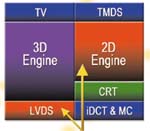ATI Mobility Radeon 9000: Raising the bar again
by Matthew Witheiler on August 29, 2002 5:00 AM EST- Posted in
- Laptops
POWERPLAY
![]() The
Mobility Radeon 9000 introduces the third generation of ATI's power management
technology. Coined POWERPLAY, the hybrid hardware/software power saving techniques
attempt to keep the power consumption of the Mobility Radeon 9000 as low as
possible.
The
Mobility Radeon 9000 introduces the third generation of ATI's power management
technology. Coined POWERPLAY, the hybrid hardware/software power saving techniques
attempt to keep the power consumption of the Mobility Radeon 9000 as low as
possible.
Hardware wise it seems that ATI did not change the fundamentals of POWERPLAY much. The technology still consists of three main features: clock gating, clock and voltage throttling, and LCD refresh rate modulation. These are all features shared by the NVIDIA GeForce4 Go series chips as well.
Clock gating gives the GPU the ability to turn off and on various portions, or blocks, of the chip depending on if they are needed or not. The logic of the chip is organized in such a way that if a specific feature of the chip is not needed it can be turned off. For example, if a given laptop is only displaying items in a 2D environment on the laptop's LCD panel, only the LVDS and the 2D engine need to be powered. The other components on the chip, like the 3D engine, the TMDS, and the MPEG-2 decode functions can be turned off. We learned that the RV250 core is highly segmented when it comes to clock gating as demonstrated by the fact that even the pixel and/or vertex shader engines can be turned off when not being used.

Clock gating, where only the needed potions of the chip are powered.
The Mobility Radeon 9000 can also vary its core speed, memory clock speed, and voltage depending on the situation that the chip encounters. ATI calls this feature "Power on Demand" and in the case of the Mobility Radeon 9000 it gives the chip the ability to clock itself at a low clock speed and voltage when the chip in an idle or low demand state. The chip runs in this power saving mode the majority of the time when the system is in a static environment. Such a situation leaves the Mobility Radeon 9000 chip running at a 80MHz core speed and a 80MHz memory speed at 1.25 volts while still maintaining the ability to drive a panel running at 1600x1200x32.
The final hardware implementation of POWERPLAY involves the laptop's LCD display. The LCD panels found on laptops are actually the most power hungry part of mobile computers, consuming a good amount of the system's battery power. To help decrease the amount of power that the LCD draws, the Mobility Radeon 9000 lowers the refresh rate on the LCD display while on battery power.
These power saving features resulted in a product that is, at most, only 10% more power hungry than its predecessor at the highest performance settings.










0 Comments
View All Comments